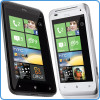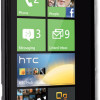Review: HTC Titan Windows Phone with Mango
The Titan runs Windows Phone 7.5 Mango from Microsoft, with only the most minor additions from HTC.
Using Mango, it is hard to pinpoint any obvious changes that stare you in the face when compared to Windows Phone NoDo, or even the launch version of Windows Phone. But as you use the platform over the course of a day, you'll see the smoothed out rough patches, longer menus, additional settings and apps, and other small indicators that tell you you're using a better platform than before. Screens are clean and clear, transitions are crisp and present, everything about the platform feels polished and like it belongs. It has a very attractive “Metro” user interface. Microsoft has done a fine job at crafting a very user-friendly smartphone platform that is extremely powerful and feature-rich.
First, on the unlock screen, there's a great set of notifications placed at the bottom of the screen that let you see in an instant what new missed calls, emails, and messages you may have received. They are easy to jump into once you unlock the phone.
The home screen is still made up of the live tiles, but you'll see that more of the tiles are dynamic, updating apps with content that changes throughout the day. Mango supports more tiles, and more types of tiles, such as email folders and message threads. You can pin these tiles — some active, some static — to the main home screen, where they can behave, in effect, like widgets. This means you don't have to go digging into the main menu for them, but place too many tiles on the home screen and your problem isn't really solved.
The Metro UI requires you to swipe your finger to the left to discover more content/info in most apps/menus you happen to be using. For example, swipe to the left from the home screen, and you go into the main menu. The main menu is where all the applications, settings, and other tools are stored. They're piled into one long list. This is perhaps one area I dislike about Mango. The more you add to the Titan, the more you have to scroll up and down this list to find stuff.
The Hub concept continues to work well. Hubs are not just apps, but places where content is centralized based on what it is. For example, the People Hub brings together not just contact data, but content generated by those contacts, such as social networking posts, photos, as well as messages, emails, and phones calls to/from them.
Most individual apps can also be adjusted through tool that are most often made visible by the presence of three little dots near the bottom of the screen. Tap these dots to make adjustments to the app in question.
Mango also brings fast app switching, which some might call multitasking. Press and hold the back button, and you'll see a collection of all the recent applications you've used in a coverflow-style layout. Simply pick the app you want to return to, and you'll jump directly there. Mango preserves the state of each app, which goes into a hibernation mode each time you switch apps. That means if you've started to type an email, and then switch to the browser and then back to the email app, your draft is preserved as-is.










 Hands-On: HTC Titan and Radar WP7 Mango Phones
Hands-On: HTC Titan and Radar WP7 Mango Phones
 Titan Tips the WP7.5 Scales In HTC's Direction
Titan Tips the WP7.5 Scales In HTC's Direction
 HTC Titan
HTC Titan




